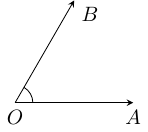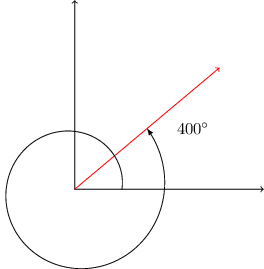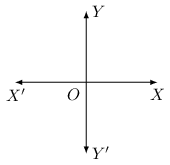2. Measurement of Angles#
The word trignometry comes from Greek(τριγωνομετρία) which includes two words; τριγωνο meaning triangle and μέτρηση which means measurement. The objective of studying plane Trigonometry is to develop a method of solving plane triangles. However, as time changes everything it has changed the scope of Trigonometry to include polygons and circles as well. A lot of concepts in this book will come from your Geometry classes in lower classes. It is a good idea to review the concepts which you have studied till now without which you are going to struggle while studying Trigonometry in this book.
2.1. Angle in Geometry#
If we consider a line extending to infinity in both directions, and a point which divides this line in two parts one on each side of the point then each part is called a ray or half-line. Thus divides the line into two rays and .

The point is called vertex or origin for these days. An angle is a figure formed by two rays or half lies meeting at a common vertex. These half lines are called sides of the angle.
An angle is denoted by the symbol followed by three capital letters of which the middle one represents the vertex and remaining two opint as you can guess point to two sides. Otherwise the angle is simply written as one letter representing the vertex of the angle.

The angle in above image is written as or or
Each angle can be measured and there are different units for the measurement. In Geometry, an angle always lie between and and negative angles are meaningless. Measure of an angle is the smallest amount of rotation from the direction of one ray of the angle to the direction of the other.
2.2. Angle in Trigonometry#
Angles are more generalized in Trigonometry. They can have positive or negative values. As was the case in geometry, similarly angles are measured in Trigonometry. The starting and ending positions of revolving rays are called initial side and terminal side respectively. The revolving half line is called the generating line or the radius vector. For example, if and are the initial and final position of the radius vector then angle formed will be
2.2.1. Angles Exceeding #
In Geometry, angles are limited to to However, when multiple revolutions are involved angles are more than 360°. For example, the revolving line starts from the initial position and makes complete revolutions in anticlockwise direction and also further angle α in the same direction. We then have a certain angle given by where and is zero or positive integer. Thus, there are infinite possible angles.

2.2.2. Sign of Angles#
Angles formed by anticlockwise rotation of the radius vector are taken as positive and angles formed by clockwise rotation of the radius vector are taken as negative.
2.3. Quadrants#

Let and be two mutually perpendicular lines in a plane and be the initial half line. The lines divide the whole reason in quadrants. and are respectively called 1st, 2nd, 3rd and 4th quadrants. According to terminal side lying in 1st, 2nd, 3rd and 4th quadrants the angles are said to be in 1st, 2nd, 3rd and 4th quadrants respectively. A quandrant angle is an angle formed if terminal side coincides with one of the axes.
For any angle which is not a quadrant angle and when number of revolutions is zero and radius vector rotates in anticlockwise directions:
if lies in first quadrant
if lies in second quadrant
if lies in third quadrant
if lies in fourth quadrant
when terminal side lies on , angle formed
when terminal side lies on , angle formed
when terminal side lies on , angle formed
when terminal side lies on , angle formed
2.4. Units of Measurement#
In Geometry, angles are usually measured in terms of right angles, however, that is an inconvenient system for smaller angles. So we introduce different systems of measurements. There are three system of units for this:
Sexagecimal or British system: In British system, a right angle is divided into equal parts called degrees. Each degree is then divided into equal parts called minutes and each minute is further is divided into parts called seconds.
A degree, a minute and a second are denoted by and respectively.
Centesimal or French System: In French system, a right angle is divided into equal parts called grades. Each grade is then divided into equal parts called minutes and each minute is further is divided into parts called seconds.
A degree, a minute and a second are denoted by and respectively.
Radian or Circular Measure: An arc equal to radius of a circle when subtends an anngle on the center then that angle is radian and is denoted by . The angle made by half of perimeter is radians. Also, from Geometry we know that angle subtended is the ratio between length of cord and radius. This ratio is in radians. Since both length or chord and radius have same unit radian is a constant.
2.4.1. Relationship between Systems of Measurements#
If measure of an angle if degrees, grades and radians then upon elementary manipulation we find that
2.4.2. Meaning of #
The ratio of circumference and diameter of a circle is always constant and this constant is denoted by gree letter .
is an irrational number. In general, we use the value of but is more accurate though not exact. If be the radius of a circle and be the circumference then leading circumference to be
2.5. Problems#
Reduce to Centisimal measure.
Reduce to
Centisimal measure
radian measure
Reduce to Sexagecimal measure.
Reduce radians in Sexageciaml measure.
Express in terms of right angle the angles
Express in grades, minutes and degrees
Express in terms of right angles and also in degrees, minutes and seconds the angles
Reduce to centisimal measure.
Reduce to circular measure.
Reduce to sexagecimal measure.
How many degrees, minutes and seconds are respectively passed over in minutes by the hour and minute hand of a watch.
The number of degrees in one acute angle of a right-angled triangle is equal to the number of grades in the other; express both angles in degrees.
Prove that the number of Sexagecimal minutes in any angle is to the number of Centisimal minutes in the same angle as
Divide into two parts such that the number of Sexagecimal seconds in one part may be equal to number of Centisimal seconds in the other part.
The angles of a triangle are in the ratio of , find the smallest angle in degrees and greatest angle in radians.
Find the angle between the hour hand and the minute hand in circular measure at half past four.
If and denote the grade measure, degree measure and the radian measure of the same angle, prove that
Two angles of a triangle are and respectively. Find the third angle in radians.
The angles of triangle are in A.P. and the number of radians in the greatest angle is to the number of degrees in the least one as ; find the angles in degrees.
The angles of a triangle are in A.P. and the number of grades in the least is to the number of radians in the greatest is ; find the angles in degrees.
Three angles are in G.P. The number of grades in the greatest angle is to the number of circular units in the least is ; and the sum of angles is . Find the angles in grades.
Find the angle between the hour-hand and minute-hand in circular measure at o’clock.
Express in sexagecimal system the angle between the minute-hand and hour-hand of a clock at quarter to twelve.
The diamter of a wheel is cm; through what distance does its center move during one rotation of wheel along the ground?
What must be the radius of a circular running path, round which an athlete must run time in order to describe meters?
The wheel of a railway carriage is cm in diameter and it makes revolutions per second; how fast is the train going?
A mill sail whose length is cm makes revolutions per minute. What distance does its end travel in one hour?
Assuming that the earth describes in one year a circle, or km. radius, whose center is the sun, how many miles does earth travel in a year?
The radius of a carriage wheel is cm, and in th of a second it turns through about its center, which is fixed; how many km. does a point on the rim of the wheel travel in one hour?
Express in terms of three systems of angular measurements the magnitude of an angle of a regular decagon.
One angle of a triangle is grades and another is degrees, while the third is radians; express them all in degrees.
The circular measure of two angles of a triangle are and . What is the number of degrees of the third angle?
The angles of a triangle are in A.P. The number of radians in the least angle is to the number of degree in the mean angle is . Find the angles in radians.
Find the magnitude, in radians and degrees, of the interior angle of 1. a regular pentagon 2. a regular heptagon 3. a regualr octagon 4. a regular duodecagon 5. a polygon with sides
The angle in one regular polygon is to that in another is , also the number of sides in the first is twice that in the second. How many sides are there in the polygons?
The number of sides in two regular polygons are as , and the difference between their angles is ; find the number of sides in the polygons.
Find two regular polygons such that the number of their sides may be to and the number of degrees of an angle of the first to the number of grades of the second as to
The angles of a qadrilateral are in A.P. and the greatest is double the least; express the least angle in radians.
Find in radians, degrees, and grades the angle between hour-hand and minute-hand of a clock at 1. half-past three 2. twenty minutes to six 3. a quarter past eleven.
Find the times 1. between fours and five o’clock when the angle between the minute hand and the hour-hand is 2. between seven and eight o’clock when the angle is
The interior angles of a polygon are in A.P. The smallest angle is and the common difference is . Find the number of sides of the polygon.
The angles of quadrilateral are in A.P. and the number of grades in the least angle is to the number of radians in the greatest is . Find the angles in degrees.
The anlges of a polygons are in A.P. The least angle is common difference is , find the number of sides in the polygon.
Find the angle subtended at the center of a circle of radius cm. by an arc of length cm.
In a circle of radius cm., what is the length of the arc which subtends an angle of at the center.
Assuming the average distance of sun from the earth to be km., and the angle subtended by the sun at the eye of a person on the earth is , find the sun’s diameter.
Assuming that a person of normal sight can read print at such a distance that the letter subtends and angle of at his eye, find what is the height of the letters he can read at a distance of 1. meters 2. meters.
Find the number of degrees subtended at the center of a circle by an arc whose length is times the radius.
Express in radians and degrees the angle subtended at the center of a circle by an arc whose length is cm., the radius of the circle being cm.
The value of the divisions on the outer rim of a graduated cicle is and the distance between successive graduations is cm. Find the radius of the circle.
The diamter of a graduated circle is cm., and the gradiuations on the rim are apart; find the distance of one graduation to to another.
Find the radius of a globe which is such that the distance between two places on the same meridian whose latitude differs by may be cm.
Taking the radius of earth to as km., find the difference in latitude of two places, one of which is km. north of another.
Assuming the earth to be a sphere and the difference between two parallels of latitude, which subtends an angle of at the eath’s center, to be km., find the radius of the earth.
What is the ratio of radii of the circles at the center of which two arcs of same length subtend angles of and ?
If an arc, of length cm., on a circle of cm. diameter subtend at the center of circle an angle of , find the value of to places of decimals.
If the circumference of a circle be divided into five parts which are in A.P., and if the greatest part be six times the least find in radians the the magnitude of the angles the parts subtend at the center of the circle.
The perimeter of a certain sector of a circle is equal to the length of the arc of a semicircle having the same radius; express the angle of the sector in degrees.
At what distance a man, whose height is m., subtend an angle of .
Find the length which at a distance of m., will subtend an angle of at the eye.
Assuming the distance of the earth from the moon to be km., and the angle subtended by the moon at the eye of a person on earth to be , find the diameter of the moon.
The wheel of a railway carriage is ft. in diameter and makes revolutions in a second; how fast is the train going?
Assuming that moon subtends an angle of at the eye of an observer, find how far from the eye a coin of one inch diameter must be held so as just to hide the moon.
A wheel make revolutions per minute. Find the circular measure of the angle described by spoke in half a second.
A man running along a circular track at the rate of miles per hour, traverses in seconds, an arc which subtends an angle of at the center. Find the diamter of the circle.